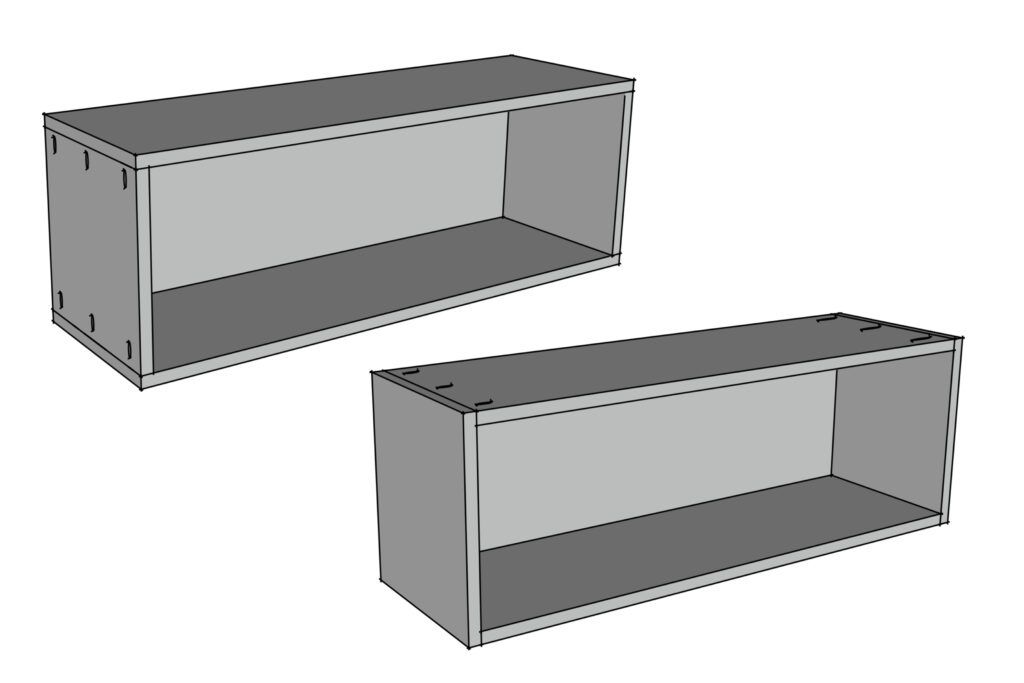We’re finally renovating our kitchen, and the first step is to raise the visual height of the room by eliminating the dead space above our short stock cabinets. To fill this space, I’m going to build a plywood box that’s slightly shorter than the gap so I can top it off with crown molding.
I’m working with a company called Fast Cabinet Doors for the doors. I gave them my measurements, and they sent me beautifully made doors with holes already bored for the hinges and a routed opening for the glass.
You are watching: How to Build Upper Kitchen Cabinets
Instructions for Building Upper Cabinet Boxes

- To get started, I ripped a sheet of plywood to the depth of my cabinets, not including the face frame. My upper cabinet boxes were 11 ¼ inches deep, meaning I could get four strips from a 4-foot wide piece of plywood.
- Next, I measured the width of my cabinet boxes, again not including the face frames or filler strips on each side. I used my miter saw to cut the strips to length to create (see illustrations) a top and bottom, two side walls between them, and a back wall inside the frame.
- I laid out the parts to drill pocket holes around the back wall’s perimeter and at the side walls’ top and bottom.
- I used glue and pocket hole screws to attach the back to the bottom board, flush with its back edge, and then added the sides with all the pocket holes facing outward. I then capped the assembly with the top board and flipped it over to check out the box.
- This is a rinse-and-repeat process as I completed the boxes for the rest of the cabinets along the fridge wall. Once I got to the microwave wall, I created one long assembly, placing the dividers where the individual cabinets connect so I could mimic their width.
- I screwed through the back wall to install the boxes, sinking just one or two screws through the boxes’ floor and into the cabinet’s frame below. Next, I was ready to build the face frames that would cover the front edge of my boxes using glue and pocket hole screws.
- I custom-ripped the width of some stiles to account for the additional filler strips below or where two cabinets met. I wanted to install one stile above.
- Once complete, I glued and nailed these frames to the face of the boxes.
- I removed the raised countertop and built two end caps to make the peninsula look like an island.
Finalizing the Look
Read more : How to Get Rid of Ants in the Kitchen
When the countertops arrived, I looked at the additional space we gained from the new configuration. To finish the look before the painters arrived, I added a corner shelf and topped the entire room with crown molding.
And just like that, the space went from dark and yellow to bright and airy. I can’t believe how much bigger the space now feels.
Read more : Stay Updated
To finish the renovation, I removed the pantry door to widen the opening, installed new flooring to match the rest of the home, installed a new backsplash, built some floating shelves for the new pantry, and worked with a company called One Day Doors to finish the space with shaker French doors, and installed new pendant lights.
Materials
- Wood glue
- Wood filler
- ¾-inch plywood to build the cabinet boxes
- 1 ¼-inch coarse thread pocket hole screws to assemble the cabinet box and face frames
- 1x2x8 boards to make the stiles and rails of the face frame
- 1x3x8 boards or sized to the width of lower cabinet rails
- 1x6x8 boards for the cabinet face frame
- Crown molding to cover the gap between the cabinet boxes and ceiling
- Cabinet doors
- Glass sized to fit cabinet door openings
Tools
Here are the tools and materials needed to complete this project.
Source: https://gardencourte.com
Categories: Kitchens
